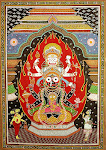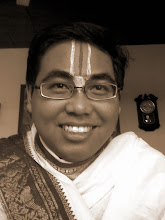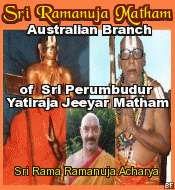
One special feature of Hindu rituals as based on Vedic and Agamic-Tantric texts were the performance of fire sacrifice called Homam or Havan. The importance of
agni (fire) and its presence in every holy rite of the Hindus was describe even in the most ancient Rigvedic texts. Even now, we can easily recognize Hindu as a religion of fire by observing the beauty of
Dipaaradhanam in the temples or the pompous celebration of annual Divali.
However today we hardly find any Homam perform by Nusantara Hindus. There is no daily waving of sacred lamp in family shrines. Though Homams profusely mentioned in many ancient sacred texts of palm leaf mostly found in Bali, with their details, benefit, and mantras respectively, but the practice has been already lost for more than 500 years. The most common
Dipaaradhanam or
Arati ceremony by waving oil lamps or flame of burning camphor as it practices in India, only do by ordained Brahmin high priests (called
Sulinggih in Balinese).
The Nusantara Hindu practices, especially in Bali, have turned to profuse using of holy water instead of sacred fire. The making, worshiping, and sprinkling of holy water are inseparable part of ALL ceremonies. For them water is the consecrated form of Divinity, mediator for prayers, purifier of the whole world, the very basis of universe, EVERYTHING. Every Hindu family is routinely visiting Brahmin high priests’ seat, their houses, called in Sanskrit term
Gria (Griha) as a sign of honor instead of
umah –mere common people’s house in Balinese, only for obtaining holy water from them. The high priests, with their Tantric methods of chanting mantras, showing
mudras, dedicating various offerings, and visualization in meditative trance, worship the scented water inside the
kumbhas (sacred vessels made from 5 kinds of metal -
panchalogam) as the Total Form of All Divinities,
Sarvadevatasvarupi. Inside the
kumbha, the essence of all holy rivers, especially Ganga, was invoked. Prayers glorifying Gangadevi, the Presiding Deity of Holy River, chant continuously by the priest while offering various
upacharas such as incense, lamp, flowers, sandalwood paste, and
akshatam with the ringing of
Ghanta, ceremonial bell. Then the priest meditate to the Supreme God as residing in his heart and projecting Him through “a divine gate” at the top of skull (
brahmarandhra) to take His seat in sanctified water. After again worshiping Him with various
upacharas, this embodiment of Ganga and all other sacred rivers then mixed with the essence of Supreme Deity. This become essence of Parasiva for the Saivas, the water of indestructible adamantine essence of enlightenment – Vajrodaka for Bauddha, and the Sripada-tirtham – water emanated from Lord Vishnu’s lotus feet for the Vaishnavas. This water has mystical potency to purify the places of worship, the offerings, peoples, and environment. Through the worship of holy water and then bestow it to the people, the priestly order harmoniously maintains its relationship with laymen and keeps the social order and environmental energies in balance.
Interestingly noticed, Ganga is worshipped by all the three sects of Nusantara Hindu priestly order, namely the Saiva, Bauddha, and Vaishnava. Though actually there is no difference in their daily practices but there are some in characteristic of their usage of hereditary obtained mantras. Today they have already united as one single Hindu clergy though in the past their lineages were different. So the Bauddhas are not real Buddhists. They are only Hindu Brahmins who mixed some of their prayers with Tantric Buddhist mantras glorify The Triratna and Paramadibuddha as The Supreme Deity. All of them worship the Hindu Trinity of Brahma, Vishnu, Siva (Isvara or Mahesvara as they preferably call him). But each sect called the Supreme Deity as the source of Trinity manifestations differently. Even the Tuturs (texts of esoteric teachings) of each sect admit it. We can see in this quote from Bauddha’s
Tutur Saṅ Hyaṅ Kamahayanikan, “
saṅ hyaṅ yogādi paramanairātmya garan ira waneh de saṅ boddha, ananta paramanandana ṅaran ira de saṅ bhairawa, mārggayogādi paramaguhya ṅaran ira de saṅ siddhānta, niṣkalādiparama ṅaran ira de saṅ weṣṇawa (language is Kawi – archaic Javanese), for the Bauddhas the supreme achievement is the Divine Paramanairatmya, the Tantric adepts called It Anantaparamananda, the Siddhantis (refers to followers of Saiva-siddhanta) called It Paramaguhya, and for Vaishnavas It is Paramadiniskala (as refer to niskala niranjana nirvikalpa narayana of Narayana Upanishad).” They don’t post themselves as different religion and rivaling sects but as worshipper of One Single Supreme Deity in different names only, as prefer by their own lineage.
 The Pedanda Saiva, Balinese Saiva high priest. His royal dress is characterized by small crystal lingas (sphatikalingam)
The Pedanda Saiva, Balinese Saiva high priest. His royal dress is characterized by small crystal lingas (sphatikalingam)These mantras are from Nusantara puja manuscripts, the paddhatis of high priest. The language called Nusantara Sanskrit or Archipelago Sanskrit. Some words already change from the original Sanskrit and sometime do ignore Panini grammar. I shall provide the translation according to how they understood traditionally, not by exactly analyzing word to word.
Saiva mantras for Ganga
gangadevi-maha-punyam soma vamrita-mangalam mangalam siva karyanam siva kumbha mahottamamThis mantra illustrate the Saiva high priest by mystical meditative transformation become identical with Parasiva Himself since The Supreme Deity was meditated as reside in his heart. As the representative of Siva, he prepares the holy water inside his great (
mahottama) Siva-kumbha, the vessel of Siva’s essence. This will bestow the world with auspiciousness (
mangalam, also sometime synonymous with
sivam). This is the holy water of fully meritorious (maha-punyam) Gangadevi , the all auspicious essence of Soma, the elixir of immortality.
ganga harayata dharma pavitram papanasanam sarva vighna vinasan ca vyomakasa prabhavatahThe constitutional nature of Ganga is destroying all sinful reactions, purifying everything, and destroying any hindrance. Her divine potency is shining effulgently in space (
akasa) and firmament (
vyoman). This refers to the divine source and celestial course of Ganga. The high priest as Siva then prepares holy water inside the kumbha by absorbing the essence of this
Ganga-prabhavam in
vyomakasa and projecting it toward his
kumbha.
brahma visnus ca rudras ca toyas tu toyadehakah amritam sakalam dehi gangadevi namo namahThis mantra glorify Gangadevi as the Trinatha/Trideva, Brahma-Vishnu-Rudra, in liquid form of water. This water is “the body (
deha)” enshrined Trideva inside. We ask Gangadevi to bestow immortality (
amrita) through her holy water, the very embodiment of Trideva.
 The Pedanda Buddha, high priest of Bauddha sect. Characterized by his using of Vajra, the adamantine sceptre of five metals, in his puja.
The Pedanda Buddha, high priest of Bauddha sect. Characterized by his using of Vajra, the adamantine sceptre of five metals, in his puja.Bauddha mantras for Ganga
mrityunjayasya devasya yo namany anukirtayet dirghayusam avapnoti sri sangha vijayi bhavetHere Ganga is glorified as the embodiment of Buddha-dharma. She is the Deity who overcome death (Mrityunjaya, traditionally a name of Lord Siva. It was accepted that Gangadevi also one of Siva’s wife and identical with Him. So may be that was the reason for addressing Her in such way. The Bauddhas are seem prefer to identify Dharma with Mrityunjaya than Siva as personal deity). By glorifying Her name we obtain long-life and victory for the Congregation.
buddha nirmala sivanam dharma sangha parayana sangha sangha yaso purna sri gangadi namo’stu teSri Gangadi refers to Ganga and other holy rivers. By saluting them which is the essence of Buddha, pure, and auspicious, the embodiment of Dharma as delivered by Sangha, may the congregation become perfectly pious.
jalanidhi mahasakti sarva siddhi dharma tirtham dharma tirthan mangalan ca sri dharmadi namo’stu teAgain we salute Ganga as embodiment of Dharma. She is the water of Dharma, the most powerful form of water, and bestowal of all perfection.
Vaishnava mantras for Ganga
gangadevi-maha-punyam ganga jalan ca medhini ganga kalasa samyuktam gangadevi namo’stu teThis Mahapunya Ganga is both Jalam and Medhini. The holy water collect in
Kalasam/Kumbham, indeed is Gangadevi Herself. We salute Gangadevi!
srigangamahadevi suksma-mrta-sanjivani omkaraksara-bhuvanam padamrita manoharaThis mantra illustrates the spiritual aspect of holy water as accepted by Vaishnava high priests. Ganga the great Goddess is subtle and sublime. Bringing life to the death. The very form of Omkara in this world. The mind captivating nectarine ambrosia emanated from Lord Vishnu’s lotus feet.
utpattika surasas ca utpattis tava ghoras ca utpatti sarvahitas ca utpatti va sarva sri-vahinamThis mantra glorify Ganga as the source or beginning (
utpatti) of these divine natures: sweet mellows (
surasa), awe and reverence (
ghora), all happiness and well being (
sarvahita), and continuous flow of all opulence (
sri-vahinam)
om jnanatirtham mahaganga sagaramalayate narayanadyagaro’pi kumbha tirtham mahanadimThis
Kumbha-tirtham is that great Ganga who flows toward the sea. This is the water of perfect knowledge (
jnanatirtham) emanated from the tips of Lord Narayana’s lotus feet.
gangadevi-maha-tirtham toyastha toyanirmalam amritas ca mahadevi sarva papa vimuktanamThis is the great holy water of Gangadevi. She abides in this water, free from all defects. The great Goddess blesses us with immortality and releases us from all sinful reactions.
utpatti surya rupena soma va sthiti mangalam avighna traya rupas ca pavitra jnana pralineThis is the mantra for worshipping Ganga in Her three fold forms in universal cycle of creation (
utpatti), maintenance (
sthiti), and dissolution (
pralina). She is
Surya (the sun),
Soma (the moon), and
Pavitrajnana, the knowledge of purification for destroying all sinful reactions. We worship Ganga in these three auspicious forms that destroy all hindrance and disturbance.
Common in three sects
om ganga-dvare prayage ca ganga-sagara-sangamam sarvangatam bhur labhate tribhih sthanair visesitamThis mantra is describing how Gangadevi bring auspiciousness to this planet. She manifests in Gangadvara, refers to the place of Ganga’s origin in Himalaya down to holy city of Haridvar, Prayag – the confluent of Ganga, Yamuna, and unvisible Sarasvati, and finally Ganga-sagara, where the river enter ocean at Bay of Bengal. All Her bodies of water bless this earth by divine potency especially in these three places.
papo’ham papa-karmaham papatma papa-sambhavah trahi mam pundarikaksah sa bahyabhyantara sucihThis mantra is chanted everyday by Nusantara Hindus in their daily prayer. This is purification mantra where the devotees express their impure condition with humility and ask Lord Vishnu, The Lotus Eyed One – Pundarikaksha, to purify their self from sin of mortal body externally and internally. “I’m full of sin, I’m act in sin, I’m the sin itself, and was born in sin. Please protect me Lotus Eyed Lord. Purify me from all sins both outward and inward.”
asucir va sucir vapi sarva kama gato’pi va cintayed deva isanam sa bahyabhyantara sucihThis is another version especially chanted by the Saiva priest. Holy or not holy, in all types of desire, just by remembering Lord Isana, we’ll be purified externally and internally. All desire or sarvakama here refers to the ritual we are going to perform.
The high priest used to bath the person by chanting this benedictory verse.
om bhur bhuvah svah svaha ye tirtha mahapavitraya namah tirtha tirtha ye nityam suddha lara suddha rogha suddha klesa suddha mala suddha pataka suddha vighna suddha papa nir upadrava om jalanidhi mahasakti hum phatThis is the great holy water purifier of the three worlds. Salute It! By accepting this tirtham may you be freed forever from all types of disturbance. Washed away all sadness, all sickness, all negative traits, all impurity, all sins, all disturbances, all inauspiciousness, no defect ever touch you.
OM the most powerful collection of water HUM PHAT
Bathing in holy water bestowed by the high priest is one of the most powerful purification rituals and highly demanded by Nusantara Hindus. This is called
Pelukatan Agung in Balinese, an elaborate form of
Prayascitta or atonement. They belief this act of faith will erase their spiritual discrepancy or even bring material success and good health by purify the negative energy from the gross and subtle body, thus releasing the soul from the burden of the effects of bad karmas. By first invoking Gangadevi and other holy rivers, worshiping her, and then taking bath in the sanctified water, the Nusantara Hindus belief this is as equal as directly bathing in those holy rivers of India. By this ritual, the ancient spiritual connection of Nusantara and India, built from thousands of years ago by our ancestors, was maintained nicely.
The grand
Pelukatan Agung performs by more than one high priest considered as more potent and supremely beneficial. The sacred texts called it
Pelukatan Agung Mahottama. The greater one, which involving invocation of Gangadevi and her worship was called
GANGAPRATISTHA. This is the ritual of manifesting Ganga with all holy rivers and
tirthams in water vessels to purify the mass. In this ceremony the essence of all purifying agents, headed by Gangadevi, were considered as directly present. Such a ceremony for centuries was never performed again in Nusantara. But this year on the last 29 August an Acharya of Balinese Hindu high priest, Ida Pedanda Gede Nabe Bang Buruwan Manuaba, revived this ancient grand ceremony once again. This took place at the shore of Bali eastern coast, in a vast courtyard of a temple called Bindu Sagara. By help of four other high priests, he gave ritual purification bath to more than 1000 people with gallons of holy water. The water was ceremoniously mixed with the real Ganga, Yamuna, and Prayag’s water directly brought from India, and then consecrated further by the high priests. With full regalia, the
Kumbha contained Ganga, Yamuna, and Prayag’s water was decorated, worshipped, and brought to parade shaded by royal umbrella, before it was mixed with gallons of scented water. First the people were bathed in water from the confluence of local river with ocean as representative of Ganga – Samudra Sangamam. Second bath was in scented water representing Prayag. The last was directly from high priests’ own kumbhas as the embodiment of holy waters flowing through Gangotri – Haridvar.
 A Balinese Hindu Acharya and High PriestIda Pedanda Gede Nabe Bang Buruwan ManuabaThe pioneer in reviving Gangapratistha ceremony in Indonesia
A Balinese Hindu Acharya and High PriestIda Pedanda Gede Nabe Bang Buruwan ManuabaThe pioneer in reviving Gangapratistha ceremony in IndonesiaThe revered Acharya also have an idea to perform even greater ceremony in the future. It will involve 108 high priests and priestesses of different sects. This also should be an international event by inviting Hindu high priests from abroad, as many as possible. The Acharya welcomes participation of all our Bhattars, Vaidikars, Smarthas, Sivacharyars and Swamis from all over the world to come to Bali on that day and join in mass prayer worshipping Gangadevi and all
tirthams, and also preparing the holy water for the people. This will be the making of “the most powerful holy water” and also grandest display of Hindu’s richness of spiritual culture in Indonesia. By the success of the first Gangapratistha after almost extinct for centuries, he was determined enough to organize this grand Nusantara Hindu Mela for the next year. I hope all of us could participate in this event and the history will note the Reemerging of Hindu Dharma in Indonesia.

 The Headpriest and priestess entering meditation before invoking Gangadevi and all tirthams
The Headpriest and priestess entering meditation before invoking Gangadevi and all tirthams
 Ida Pedanda Gede Nabe Bang Buruwan Manuaba giving holy water bath at Gangapratistha ceremony
Ida Pedanda Gede Nabe Bang Buruwan Manuaba giving holy water bath at Gangapratistha ceremony
 The Balinese Padmabhuvana-mandala
The Balinese Padmabhuvana-mandala Table of The Abodes of Maha-bhayas, The Supreme Terror - Destroyer of All Enemies (click for larger view)
Table of The Abodes of Maha-bhayas, The Supreme Terror - Destroyer of All Enemies (click for larger view) Bigger Homatraya-agni-kundam with various offering
Bigger Homatraya-agni-kundam with various offering Homatraya-agni-kundam shining in the night
Homatraya-agni-kundam shining in the night OM (in Balinese alphabet), shining jewel inside the lotus
OM (in Balinese alphabet), shining jewel inside the lotus A Balinese couple accepts Mandi Weda from Highpriest
A Balinese couple accepts Mandi Weda from Highpriest















































